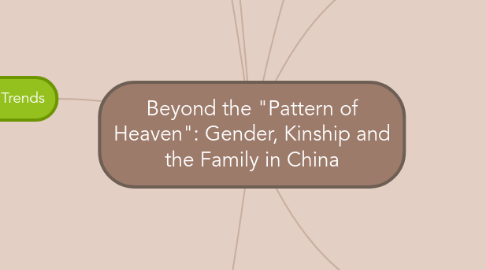
1. traditional Chinese culture
1.1. heavy Confucian influence
1.1.1. extreme patrilineality
1.1.1.1. women play an invisible role
1.2. Han
1.2.1. 92% of China
1.2.1.1. most male-centric kinship systems
1.2.2. Han Dynasty
2. Confucian tradition
2.1. founded by Kong Fuzi in 6th century B.C.
2.2. an open system
2.2.1. people (mainly men) join through self cultivation rather than birth
2.2.2. anyone is allowed
2.3. The Classic of Filial Piety
2.3.1. "the pattern of Heaven"
2.3.1.1. without it, human kind is subject to chaos
2.3.2. children must honor their parents equally
2.3.2.1. lip service as woman are not treated equally
2.4. women
2.4.1. encouraged to be a good wife and mother
2.4.2. help the men in their life become junzi
2.5. men
2.5.1. strive to become junzi (gentlemen)
2.6. five relationships
2.6.1. ruler/ minister
2.6.2. father/ son
2.6.3. elder brother/ younger brother
2.6.4. husband/ wife
2.6.5. friend/ friend
2.6.6. the foundation of Chinese society
2.6.7. avoid conflict
3. Post 1949 Trends
3.1. People's republic
3.1.1. strengthened traditional Chinese family
3.1.1.1. public health
3.1.1.1.1. assistance during widespread famines
3.1.1.1.2. increased life span
3.1.1.2. new residence laws
3.1.1.3. migration laws
3.1.1.3.1. restricts males and their sons to go back to their natal home
3.2. Constitution and CCP
3.2.1. provided women with de jure laws
3.2.1.1. the right to divorce
3.2.2. abandon superstitious practices
3.2.2.1. ancestor worship
3.2.3. one-child policy
3.2.3.1. second one is allowed only if the first died or severely handicapped
3.2.3.2. first implemented by birth control laws
3.2.3.3. 1993- could bear a second child if first is female
3.2.3.3.1. ultrasounds
3.2.3.4. male/female ratio
3.2.3.4.1. females are underreported
3.2.3.5. social reprocussions
3.2.3.5.1. lack of care for elderly
4. alternate models of kinship and the family in china
4.1. The Dai
4.1.1. Xishuangbanna
4.1.1.1. "twelve rice growing regions"
4.1.2. bilateral
4.1.2.1. descent through both female and male lines
4.1.2.1.1. no corporate lineage
4.1.2.2. lack surnames
4.1.2.2.1. women names start with Yi
4.1.2.2.2. men names start with Ai
4.1.3. matrilocal post-marriage residence pattern
4.1.3.1. husbands move into their bride's natal home for 3 years
4.1.3.1.1. provide for the woman's family
4.1.4. divorce
4.1.4.1. Marriage Law of 1950
4.1.4.1.1. man or woman may request a divorce
4.1.5. name changing
4.1.5.1. based on the eldest child
4.1.5.1.1. "mother of so-and so" or "father of so-and-so"
4.2. The Lahu
4.2.1. Myanmar, Laos, Thailand, Vietnam, and China
4.2.2. high degree of gender equality
4.2.2.1. household is ran jointly between man and female
4.2.2.2. bilateral
4.2.2.2.1. based on the married couple rather than individual
4.2.2.2.2. husband helps with all stages of pregnancy
4.3. The Mosuo
4.3.1. southwest China
4.3.2. matrilineal
4.3.2.1. "walking marriage"
4.3.2.1.1. initiated by either male or female interested
4.3.2.1.2. functions without husbands or fathers
4.3.2.1.3. children born belong to the household
4.3.2.1.4. lack of formalized marriage
4.3.2.2. female line is corporate
5. Patrilineal Kinship
5.1. filial piety
5.2. limited role played by women
5.2.1. only noted as daughters, wives, and mothers, not individuals
5.2.2. women remarried or divorced would not be marked in family tree of husband
5.2.2.1. marriage was "terminated"
5.2.2.2. important for economic and political concerns
5.2.2.2.1. corporate lineage
5.2.3. only seen to carry on lineage
6. The Surname
6.1. relative age
6.1.1. great great grandfather
6.2. mothers side
6.2.1. more general
6.2.1.1. one term
6.3. marriages must be arranged outside of broad groups
6.3.1. not all members of surname are related
7. life stages of the Han Chinese Woman
7.1. uterine family
7.1.1. Wolf
7.1.1.1. mothers and their children who belonged to her husband's patriline
7.1.1.1.1. patrilineal bonds were enforced by ritual
7.1.1.1.2. should not be seen as more egalitarian toward women
7.1.1.1.3. Confucian element
7.1.2. mother-in-law in competition with bride
7.1.2.1. son's attention
7.1.2.2. bride is making new uterine family
7.1.2.3. responsibility is transferred
7.1.2.3.1. not against each other
7.1.3. restricted by one-child policy
7.2. women should defer to men through out their lives
7.2.1. first to fathers
7.2.1.1. then to husbands
7.2.1.1.1. then to sons
7.3. became the property of her husband's patrilineal
7.3.1. was expected to provide male heirs
7.3.2. expected to serve mother-in-law
7.4. husband and wife
7.4.1. raised as siblings
7.5. divorce
7.5.1. impossible for a woman to initiate
7.5.2. expelled from husbands patrilineal
7.5.2.1. bareness
7.5.2.2. wanton conduct
7.5.2.3. neglect of her in-laws
